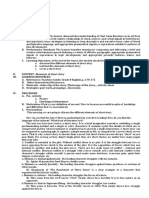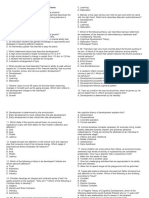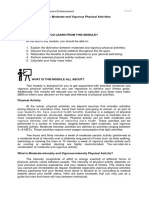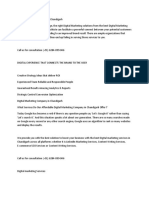0 ratings0% found this document useful (0 votes)
14 viewsUGE 1 - Elements of A Story
UGE 1 - Elements of A Story
Uploaded by
Li OchiaThis document summarizes key elements of stories including setting, characters, plot, point of view, theme, and conflict. It defines these elements and provides examples. Setting establishes where and when the story takes place. Characters can be round, flat, dynamic, or static. The plot is the sequence of events with an introduction, rising action, climax, falling action, and resolution. Point of view can be first, second, or third person. The theme is the overall message or lesson conveyed. Conflict drives the story and can be external between people or nature, or internal within a character.
Copyright:
© All Rights Reserved
Available Formats
Download as DOCX, PDF, TXT or read online from Scribd
UGE 1 - Elements of A Story
UGE 1 - Elements of A Story
Uploaded by
Li Ochia0 ratings0% found this document useful (0 votes)
14 views2 pagesThis document summarizes key elements of stories including setting, characters, plot, point of view, theme, and conflict. It defines these elements and provides examples. Setting establishes where and when the story takes place. Characters can be round, flat, dynamic, or static. The plot is the sequence of events with an introduction, rising action, climax, falling action, and resolution. Point of view can be first, second, or third person. The theme is the overall message or lesson conveyed. Conflict drives the story and can be external between people or nature, or internal within a character.
Original Description:
UGE 1
Original Title
UGE 1_Elements of a Story
Copyright
© © All Rights Reserved
Available Formats
DOCX, PDF, TXT or read online from Scribd
Share this document
Did you find this document useful?
Is this content inappropriate?
This document summarizes key elements of stories including setting, characters, plot, point of view, theme, and conflict. It defines these elements and provides examples. Setting establishes where and when the story takes place. Characters can be round, flat, dynamic, or static. The plot is the sequence of events with an introduction, rising action, climax, falling action, and resolution. Point of view can be first, second, or third person. The theme is the overall message or lesson conveyed. Conflict drives the story and can be external between people or nature, or internal within a character.
Copyright:
© All Rights Reserved
Available Formats
Download as DOCX, PDF, TXT or read online from Scribd
Download as docx, pdf, or txt
0 ratings0% found this document useful (0 votes)
14 views2 pagesUGE 1 - Elements of A Story
UGE 1 - Elements of A Story
Uploaded by
Li OchiaThis document summarizes key elements of stories including setting, characters, plot, point of view, theme, and conflict. It defines these elements and provides examples. Setting establishes where and when the story takes place. Characters can be round, flat, dynamic, or static. The plot is the sequence of events with an introduction, rising action, climax, falling action, and resolution. Point of view can be first, second, or third person. The theme is the overall message or lesson conveyed. Conflict drives the story and can be external between people or nature, or internal within a character.
Copyright:
© All Rights Reserved
Available Formats
Download as DOCX, PDF, TXT or read online from Scribd
Download as docx, pdf, or txt
You are on page 1of 2
UGE 1
Elements of a Story Characters can be:
Story Elements: Round- fully developed personalities
that are affected by the story’s events;
1. Setting they can learn, grow or determine by
2. Characters the end of the story.
3. Plot Flat- one-dimensional character.
4. Point of View Dynamic- character who does go
5. Theme through change and grows during a
Setting is the “where and when” of a story. It story.
is the time and place during which the story Static- character does not go through
takes place. a change.
When examining how setting contributes to a Plot
story, there are multiple aspects to consider: How the author arranges events to develop
Place the basic idea; it is the sequence of events in
Time a story or play. The plot is a planned, logical
Weather Conditions series of events having a beginning, middle
Social Conditions and end. The short story usually has one plot
Mood or atmosphere so it can be read in one setting.
The functions of SETTING:
To create a mood or atmosphere
To show a reader a different way of life
To make action seem more real
To be the source of conflict or struggle
To symbolize an idea
Characters
A person in a fictional story; Parts of a Plot:
Qualities of a person Exposition - introduction; characters, setting
People in a work of fiction can be a (an): and conflict (problem) are introduced
Protagonist- clear center of story, all major Rising Action- events that occur as result of
events are important to this character. central conflict
Antagonist- opposition or enemy of main Climax- highest point of interest or suspense
character. of a story
Characteristics of a CHARACTER can be Falling Action - tension eases; events show
revealed through: the results of how the main character begins
to resolve the conflict
His/her physical appearance.
What he/she says, thinks, feel, dreams Resolution- loose ends are tied up; the
and what he/she does or does not do. conflict is solved
What others say about him/her and
how others react to him/her.
UGE 1
Conflict Example: You wake up to discover that you
have been robbed of all your worldly
-conflict is the dramatic struggle between two possession.
forces in a story. without conflict, there is no
plot. 3. Third person- story is told by a
narrator who sees all of the action;
conflict is a problem that must be speaker uses the pronouns “he”, “she”,
solved; an issue between the “if”, “they”, “his”, “hers”, “its” and
protagonist and antagonist forces. it “theirs”. This person may be a
forms the basis of the plot. character in the story. There are
conflicts can be external or internal several types of third person POV.
o external conflict- outside force limited- the narrator knows the
may be person, group, animal, thoughts and feelings on only one
nature, or a nonhuman obstacle character in a story.
o internal conflict- takes place in Third person omniscient- the
a character’s mind narrator knows the thoughts and
feeling of all the characters in a
External Conflict
story.
1. Character VS Character- struggles
Omnipotent- meaning all-powerful
against other people.
2. Character VS Nature- struggles Omniscient- meaning all-knowing
against animals, weather, environment
Omnipresent-meaning present everywhere at all
etc. times.
3. Character VS Society- struggles
against ideas, practices, or customs of Theme
others.
the theme is the central, general
Internal Conflict message, the main idea, the
controlling topic about life or people
Character VS self- struggles with own soul, the author wants to get across through
physical limitations, choices, etc. a literary work
to discover the theme of a story, think
Point of View (POV)
big. what big message is the author
The angle from which the story is told. There trying to say about the world in which
are several variations of POV. we live?
what is this story telling me about how
1. First person- story is told by the life works, or how people behave?
protagonist or a character who
interacts closely with the protagonist or The practical lesson ( moral) that we learn
other characters; speaker uses the from a story after we read it. the lesson that
pronoun “I”, “me”, “we”. Readers teaches us what to do or how to behave after
experiences the story through this you have learned something from a story or
person’s eyes and only knows what something that has happened to you.
he/she knows and feels.
Example: The lesson or teaching of the story
2. Second person- story is told by a
is be careful when you’re offered something
narrator who addresses the reader or
for nothing.
some other assumed “you”; speaker
uses pronouns “you”, ”your” and
“yours”.
You might also like
- PP 2021 Icas en Eng D CDocument46 pagesPP 2021 Icas en Eng D CChu Steven100% (1)
- LitCharts War PhotographerDocument18 pagesLitCharts War PhotographerDavid100% (1)
- Motion To Discharge of An Accused To Be A State WitnessDocument3 pagesMotion To Discharge of An Accused To Be A State WitnessKM Mac100% (2)
- Elements of FictionDocument26 pagesElements of FictionBien Golecruz100% (1)
- Lesson 07-08 - Creative WritingDocument12 pagesLesson 07-08 - Creative Writingurhen50% (2)
- Living AyurvedaDocument46 pagesLiving AyurvedaDumitru Mihaela Elena100% (7)
- Creative Writing - Lesson 4Document7 pagesCreative Writing - Lesson 4Rich CatiganNo ratings yet
- Lesson 4 - Fiction WritingDocument7 pagesLesson 4 - Fiction WritingRich CatiganNo ratings yet
- Elements of FictionDocument36 pagesElements of FictionMarra CantoriaNo ratings yet
- Introduction - Short StoryDocument18 pagesIntroduction - Short Storyrahgu ramNo ratings yet
- Worksheet - Elements of Short StoryDocument3 pagesWorksheet - Elements of Short Storymaureen mae mana-ay100% (2)
- JopelDocument8 pagesJopelJoelina March Jaspe HuangNo ratings yet
- Six Elements of FictionDocument4 pagesSix Elements of FictionJaenal MutaqinNo ratings yet
- Six Elements of Fiction:: I. PlotDocument3 pagesSix Elements of Fiction:: I. PlotJestone Salut Villegas100% (1)
- Elements of A Short StoryDocument3 pagesElements of A Short StoryKans SisonNo ratings yet
- Glossary of Literary TermsDocument5 pagesGlossary of Literary TermsDivesh Senthil100% (1)
- Elements of A StoryDocument21 pagesElements of A StoryWahyu Indah PratiwiNo ratings yet
- Elements of A NarrativeDocument3 pagesElements of A NarrativeRose Suminguit Navarro100% (1)
- Elements of A Short StoryDocument51 pagesElements of A Short StoryTiffany GawNo ratings yet
- Elements of A StoryDocument17 pagesElements of A StoryReywen SentoriasNo ratings yet
- THE SIX ELEMENT-WPS OfficeDocument6 pagesTHE SIX ELEMENT-WPS OfficeGilang Satia LaksanaNo ratings yet
- REVIEWER 21stDocument5 pagesREVIEWER 21stMarjorie TarogNo ratings yet
- FICTIONDocument4 pagesFICTIONMarkisky VinzouteNo ratings yet
- Identifies The Elements of Fiction and Its Function.: Department of Education (Deped)Document5 pagesIdentifies The Elements of Fiction and Its Function.: Department of Education (Deped)MARIAN TIMTIMANNo ratings yet
- Fiction Lecture 20232024 2Document9 pagesFiction Lecture 20232024 2nprestoza5No ratings yet
- LESSON PLAN IN Elements of Short StoryDocument3 pagesLESSON PLAN IN Elements of Short StoryMerrian Perez - SibolinaoNo ratings yet
- Elements of A StoryDocument24 pagesElements of A StoryjohnlloyddacalanioNo ratings yet
- Short Story ElementsDocument3 pagesShort Story Elementsapi-304911738No ratings yet
- Elements of The Short Story NotesDocument8 pagesElements of The Short Story NotesAnonymous q66p7mP4No ratings yet
- SurphilDocument58 pagesSurphilJan Kate Valledor LambiquitNo ratings yet
- Settings-Are Known As The Time and Place Where The Story Happens. It Is An Important Element of Fiction AsDocument2 pagesSettings-Are Known As The Time and Place Where The Story Happens. It Is An Important Element of Fiction AsJohnReir0% (1)
- English 10 Quarter 1 - Week 7 8Document11 pagesEnglish 10 Quarter 1 - Week 7 8trishamae pimentelNo ratings yet
- Ninth and Tenth TopicDocument31 pagesNinth and Tenth TopicJustine CamposoNo ratings yet
- Elementa of A Good Short Story HandoutDocument4 pagesElementa of A Good Short Story HandoutCarlos Andres MantillaNo ratings yet
- Elements of Short Story SettingDocument3 pagesElements of Short Story SettingRezel C. PerezNo ratings yet
- Short Story TerminologyDocument2 pagesShort Story Terminologyapi-203814269No ratings yet
- Elements of Literature: Corona, Darren Joy B. ACT 184Document4 pagesElements of Literature: Corona, Darren Joy B. ACT 184Deo CoronaNo ratings yet
- Handouts - Elements of Short Story.Document2 pagesHandouts - Elements of Short Story.Maureen Mae EstanolNo ratings yet
- Elements of A StoryDocument18 pagesElements of A StoryRishitNo ratings yet
- Elements of A Story PDFDocument18 pagesElements of A Story PDF143airenNo ratings yet
- FICTION and Dead StarsDocument4 pagesFICTION and Dead Starsjohn mark escalaNo ratings yet
- Introduction To Prose FictionDocument2 pagesIntroduction To Prose FictionTaaboNo ratings yet
- Elements and Characteristics of Short StoriesDocument4 pagesElements and Characteristics of Short StoriesRiskaNo ratings yet
- Elements of Short StoryDocument22 pagesElements of Short StoryPhobe an MarcaidaNo ratings yet
- Five - Elements - of - Fiction - Week 07Document5 pagesFive - Elements - of - Fiction - Week 07saiitmuratovanNo ratings yet
- Fiction: Is An Imaginative Recreation of LifeDocument12 pagesFiction: Is An Imaginative Recreation of LifeYonese GonzalesNo ratings yet
- Short Story ElementsDocument2 pagesShort Story Elementsbayangjasmine.12No ratings yet
- Lesson 4Document26 pagesLesson 4Chennille Ann Bleu GundayaoNo ratings yet
- Elements of A Short StoryDocument9 pagesElements of A Short StoryAkio ValetinoNo ratings yet
- Creative Non-Fiction 12 Literary Devices, Elements & TechniquesDocument4 pagesCreative Non-Fiction 12 Literary Devices, Elements & TechniquesShendy AcostaNo ratings yet
- Five Elements of FictionDocument2 pagesFive Elements of FictionSabel Ross Caliliw0% (1)
- CNF Lesson 2Document4 pagesCNF Lesson 2Shendy Acosta100% (1)
- Lecture No. 4Document2 pagesLecture No. 4Rechman AvilaNo ratings yet
- FictionDocument3 pagesFictionDanniNo ratings yet
- Short Story ElementsDocument27 pagesShort Story ElementsGlormarie Nieves100% (2)
- Week 4 Topic 1 Elements of A Short StoryDocument41 pagesWeek 4 Topic 1 Elements of A Short StoryJOHN MEL ANDICONo ratings yet
- Lesson 1: Elements of FictionDocument17 pagesLesson 1: Elements of FictionDollie De Fiesta100% (1)
- Short StoryDocument4 pagesShort StoryJovelyn VillasenorNo ratings yet
- Elements of FictionDocument22 pagesElements of FictionSabel Ross CaliliwNo ratings yet
- Lesson 2 - Literary TextsDocument24 pagesLesson 2 - Literary TextsIvan Jhon Durana GutierrezNo ratings yet
- Handout 9 Final - 21st Lit - Elements and Creative Representation of A Literary TextDocument4 pagesHandout 9 Final - 21st Lit - Elements and Creative Representation of A Literary TextCayte VirayNo ratings yet
- Lit - Elements HandoutDocument2 pagesLit - Elements HandoutDenise CañaNo ratings yet
- I Want to Be a Writer: A Guide to Writing Short Stories: I Want to Be a Writer, #2From EverandI Want to Be a Writer: A Guide to Writing Short Stories: I Want to Be a Writer, #2No ratings yet
- The Construction of Character: A Wait, Wait, Don't Query (Yet!) BookFrom EverandThe Construction of Character: A Wait, Wait, Don't Query (Yet!) BookNo ratings yet
- Child and Adolescent Development LET ReviewerDocument8 pagesChild and Adolescent Development LET ReviewerLi OchiaNo ratings yet
- LP 100 - Principal Forms of A VerbDocument9 pagesLP 100 - Principal Forms of A VerbLi OchiaNo ratings yet
- Language Acquisition VsDocument1 pageLanguage Acquisition VsLi OchiaNo ratings yet
- EDUC 102 - FinalsDocument2 pagesEDUC 102 - FinalsLi OchiaNo ratings yet
- Elt 211 - Family TreeDocument1 pageElt 211 - Family TreeLi OchiaNo ratings yet
- GPE 1 Module5Document5 pagesGPE 1 Module5Li OchiaNo ratings yet
- EDUC 101 Development TheoriesDocument13 pagesEDUC 101 Development TheoriesLi OchiaNo ratings yet
- Broachure MILDocument4 pagesBroachure MILLi OchiaNo ratings yet
- GPE 1 Module7Document8 pagesGPE 1 Module7Li OchiaNo ratings yet
- Educ 101 - Revised Developmental Theories and Other Relevant TheoriesDocument11 pagesEduc 101 - Revised Developmental Theories and Other Relevant TheoriesLi OchiaNo ratings yet
- EDUC 102 Education Technology ReviewerDocument6 pagesEDUC 102 Education Technology ReviewerLi OchiaNo ratings yet
- Retrofit of Reciprocating Compressors - Hoerbiger ElectricDocument22 pagesRetrofit of Reciprocating Compressors - Hoerbiger ElectricRadu BabauNo ratings yet
- Mechanical Engineering CurriculumDocument8 pagesMechanical Engineering CurriculumaoguNo ratings yet
- 3.tumori Hipofizare 2018Document83 pages3.tumori Hipofizare 2018Oana AndreeaNo ratings yet
- Hepatobiliary SystemDocument131 pagesHepatobiliary SystemCurt Leye RodriguezNo ratings yet
- PHASE I (The Outline of The Foundation) (4-5 Weeks)Document3 pagesPHASE I (The Outline of The Foundation) (4-5 Weeks)AhmadNo ratings yet
- Opinion EssayDocument2 pagesOpinion EssayNaroha Perea lucasNo ratings yet
- Discrete Mathematics and Its Application - Chapter 9Document70 pagesDiscrete Mathematics and Its Application - Chapter 9Funkey dunkey100% (1)
- He Iver of Old: Jeena Rani MarquezDocument16 pagesHe Iver of Old: Jeena Rani MarquezJovy EuqardajNo ratings yet
- AashtoDocument2 pagesAashtophanna100% (1)
- Digital Marketing Company in ChandigarhDocument8 pagesDigital Marketing Company in ChandigarhDigital Marketing Company in ChandigarhNo ratings yet
- Gangrel Antitribu CityDocument1 pageGangrel Antitribu CityKasper AchtonNo ratings yet
- The Narrative Study of Self and SocietyDocument18 pagesThe Narrative Study of Self and Society吴善统No ratings yet
- Clinical ChemistryDocument1 pageClinical Chemistryaiai0% (1)
- Department of Education: I. Encircle The Letter of The Correct AnswerDocument2 pagesDepartment of Education: I. Encircle The Letter of The Correct AnswerJhonabie Suligan Cadeliña100% (2)
- Kage Guide (Expanded Class - Subclass Draft)Document42 pagesKage Guide (Expanded Class - Subclass Draft)João Vitor Ferrari Campassi0% (1)
- How To Write A Book Report. EnglishDocument2 pagesHow To Write A Book Report. EnglishKit Anton MacalosNo ratings yet
- 6 Essential Skills For Reading ComprehensionDocument5 pages6 Essential Skills For Reading ComprehensionSaleem Raza100% (1)
- The First Snowfall - Gergő - SipkaDocument2 pagesThe First Snowfall - Gergő - SipkaSipka GergőNo ratings yet
- Mayo V SatanDocument2 pagesMayo V SatanRix MigriñoNo ratings yet
- Sounds & Spelling of Irish/Fuaimeanna Agus Litriú Na GaeilgeDocument4 pagesSounds & Spelling of Irish/Fuaimeanna Agus Litriú Na GaeilgeJoy L AndersonNo ratings yet
- Islamic Finance Iqbal KhanDocument16 pagesIslamic Finance Iqbal KhanCizat MursalNo ratings yet
- Training Evaluation - Google FormsDocument5 pagesTraining Evaluation - Google Formsapi-478664699No ratings yet
- Mechanical Engineering: CAESAR II Receives TD12 Approval by TranscoDocument20 pagesMechanical Engineering: CAESAR II Receives TD12 Approval by Transcofileseeker100% (1)
- Unit 1 An Overview of Ethics, Ethics For IT Workers and IT UsersDocument34 pagesUnit 1 An Overview of Ethics, Ethics For IT Workers and IT UsersPiyush KoiralaNo ratings yet
- Week 11 Powerpoint SLP Forensic ChemistryDocument52 pagesWeek 11 Powerpoint SLP Forensic ChemistrySheena De Guzman MorenoNo ratings yet
- One Secret Side Effect of Walking Faster ArticleDocument2 pagesOne Secret Side Effect of Walking Faster ArticleANIK SAHANo ratings yet




































































































